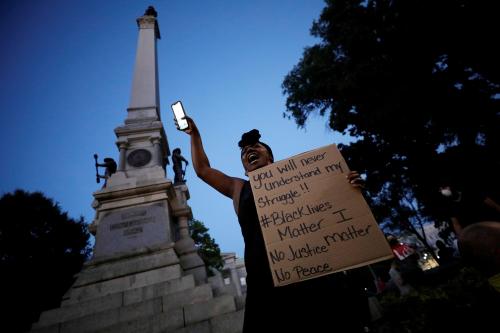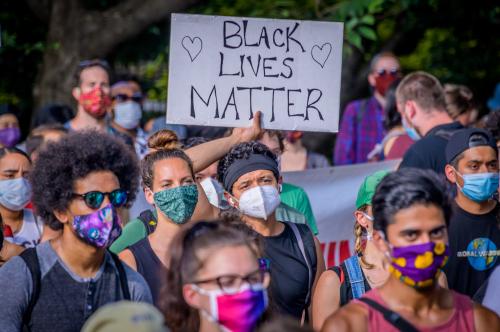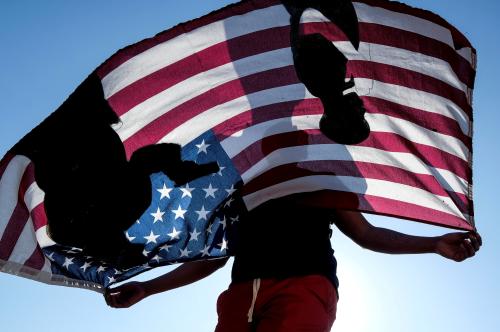This summer began the first hearing of the U.S. House Select Committee investigating the January 6th attack on Capitol Hill. The insurrection’s review invites fresh examination about the ideology, symbolism, and aesthetics defining race and America today.
There is a war being waged on the fault lines of the symbolic. As individuals took to the streets to labor on behalf of Black life, the destruction of monuments and other edifices has taken a front-row seat in the struggle towards an anti-racist future. While the toppling of artifacts and iconography of the past may seem like token gestures, they are part of a tradition of creative protest that focus on aesthetics and should serve as a model to advance organizations and society towards social change.
Aesthetics and art’s role in advancing political visions was most recently on display during the Capitol riot earlier this year. The mob came armed, not only with weapons but with far-right symbols, battle colors of the Confederacy, white supremacist emblems, ultra-nationalist and Blue Lives Matter signs, and other associated clothing and flags interspersed between pro-Trump campaign paraphernalia. Protestors utilized this symbolism to unify, powerfully connote their objectives, and mark their conquest of the Capitol. A rioter was seen removing an American flag and replacing it with a Trump flag in the institution’s rotunda to signal that space was mapped in their ideological garb.
The deployment of art, symbols, and representation has not only been utilized by Capitol rioters but is an integral part of the Black Lives Matter resistance. From the Mayor of D.C. painting the space in front of the White House, ‘Black Lives Matter’ plaza; to racist edifices being torn down that memorialized slave traders like a statue in Bristol, England. From films like ‘Gone With the Wind’ being placed in historical context; to the ongoing debate about removing Confederate names and iconography in NASCAR and military installations. Art has been a site of resistance against white supremacy and the history of extrajudicial killings by police.
Stakes around this issue rose as former U.S. President Donald Trump mobilized the military to protect monuments and enacted an Executive Order to increase prosecution of those who damaged these exhibits. This policy formed part of the justification for a surge in federal forces dispatched to American cities including my hometown of Chicago. Describing the danger, the 45th President noted that, “our nation is witnessing a merciless campaign to wipe out our history, defame our heroes, erase our values….” Trump’s words represent the importance of symbols in crafting history and defining our future. At issue is not just damage of artifacts, but embodies a larger struggle of ethics and what we stand for as a nation.
Drawing from America’s past reveals that aesthetics has always played a role in shaping politics. For instance, the significant proliferation of Confederate statues and monuments by organizations like the United Daughters of Confederacy was part of a well-conceived plan to mythologize the Civil War. The fight to keep slavery was depicted as a noble cause from a benign institution to engender sympathy. This message helped solidify white Southern national identity and embolden racist power holders and vigilantes while terrorizing African Americans by projecting white supremacy.
Juxtaposed from these efforts is the Black Arts Movement of the 1960s and early 1970s. This movement championed the “Black Aesthetic,” which weaved art and activism to detail the particularities of African American struggles, strength, and experience. To embody the aesthetic, Black artists drew on Black musical forms, especially jazz; Black hyper-masculinity to challenge historical degradation of African American men; Black vernacular speech; and experimentation with grammar and sound conventions. The movement, rooted in civil rights struggles, is considered the cultural sister of the Black Power Movement because it sought to transform the portrayal of African Americans in mainstream society, awaken Black consciousness, build Black community, and provide an impetus for their self-determination.
These examples of art from the Confederacy and Black Arts Movement, which helped to diminish and amplify Black life, illustrate how cultural production often serves an essential role in creating the type of society we would like to see. As we witness this aesthetic struggle play out in the streets today, it is essential to understand that this conflict is not an external fight — resigned to protestors attempting to remake public landscapes and advance political visions, eluding the rest of us. Instead, it holds significant lessons for organizations as they reflect on how to achieve inclusive Black futures.
Institutions need to be thoughtful not only about who is in their space (increased Black and brown bodies) or what is taught in their space (diversity training or intersectional instruction), but also an institution’s aesthetics itself (how space is curated and experienced). A space’s construction signals what it values; facilitates specific encounters; produces certain knowledge amongst its inhabitants; reinforces culture; and can serve to welcome or exclude Black, Indigenous, and other marginalized communities. Numerous studies have detailed the impact of space design on achieving academic and workplace outcomes, but usually the focus for organizations is on enhancing innovation, performance, or safety (especially in light of the ongoing pandemic). What protestors are teaching us is that an organization’s space also bears on its ethical commitments.
I understand the power of an institution’s space and construction aiding equity goals firsthand. As a student at Northwestern University School of Law in Chicago, I co-founded the Visibility Initiative. The project championed alternative aesthetics and facility construction that promoted social justice, human rights, inclusion for persons with disabilities, and diverse voices in the legal community. At the school, elite portraits and paintings featuring white men were a constant, reinforcing the idea of law as only serving a narrow community, dominated by judges and lawyers, and entrenched in power and privilege. Elevating different cultural expression such as sculpture, photography, graffiti, and performance art gave prominence to significant movements and actors like community activists, faith leaders, and artists that helped expand rights and equality under the law.
Additionally, I worked with other law students to use art to discuss social issues in Chicago through theatre productions; host photography exhibits where we brought the voices of urban youth onto campus; establish the Black Law Students annual ‘Open Mic Night’ featuring poetry, song, and introspection; and even in my academia to incorporate the local community.
After these events, several students and faculty expressed feeling more invested in the school since it began to reflect their reality and closer to their peers because they felt comfortable being vulnerable in these settings. Many were pleased that community engagement and marginalized topics were finally discussed in ways that engendered empathy and action. For me, however, the impact was simple: I felt less alone.
These illustrations highlight what is possible through an intentional focus on art and aesthetics to enhance the inclusive climate of academic, business, religious, and other institutions of society. Art affirms through culture, expression, and connection. That is all Black people want: for their freedom and truth to animate the unfolding story of humanity.
In our pursuit of a more just world, many are understandably weary of concentrating on aesthetic disruptions, preferring substantive change to symbolism. But the passage of laws does not equate to their enforcement. Policy implementation happens by people, and the aesthetics of their lived environment helps shape their behavior, understanding, taste, and moral connection to others. To be represented in public space as inferior, as depicted in this Boston statue that has drawn criticism of Abraham Lincoln standing over a kneeling Black man, normalizes exclusion. If the decision to fight for macro-level change is ultimately the choice between life and death, then things that help determine how one views Black bodies (as a threat or as human) are also important.
Not only will policy execution be enhanced, aesthetic focus prompts specific interventions into the political, such as:
- Commissioning inclusive public art: Ideas that should be memorialized include everyday heroes sacrificed like Breonna Taylor and George Floyd, peaceful protestors and workers whose labor continues to advance society, and women whose limited representation in public spaces is thought to only be 7% in the United States.
- Adopting Participatory Budgeting (PB): PB conceives of people not just as citizens, but creative subjects whose radical collective imagination determines what is best for their community. The process — already underway in major U.S. cities like New York and Chicago — allows citizens, like artists, to be visionaries by giving them direct control over public spending of a portion of government’s budget. Research shows that with PB, spending priorities of municipalities change to better reflect community’s needs, and it improves inclusion of traditionally disempowered voices. Citizens ideating, interacting, and collaborating through PB also fosters greater understanding, shared values, belonging, and collective definitions of what should occupy our public spaces. This is why art-civic collectives such as the U.S. Department of Arts and Culture, Arts & Democracy, and Warm Cookies of the Revolution have been championing the process as a mechanism to reinvigorate democracy through creativity.
Pursing a new world requires reengineering policies and processes, but it also starts with the locations we inhabit every day. If you are committed to anti-racism, it means committing to creating anti-racist spaces, too. The values elevated by Black Lives Matter need to be reflected throughout society as a constant reminder of what we are fighting for, inside our institutions of public life, and outside on our streets as well.
Chime Asonye is a lawyer and development practitioner. He is a former Commissioner of the Washington, D.C. Commission on African Affairs.






Commentary
The art of Black Lives Matter: Lessons for organizations and policymakers from the streets
September 15, 2021